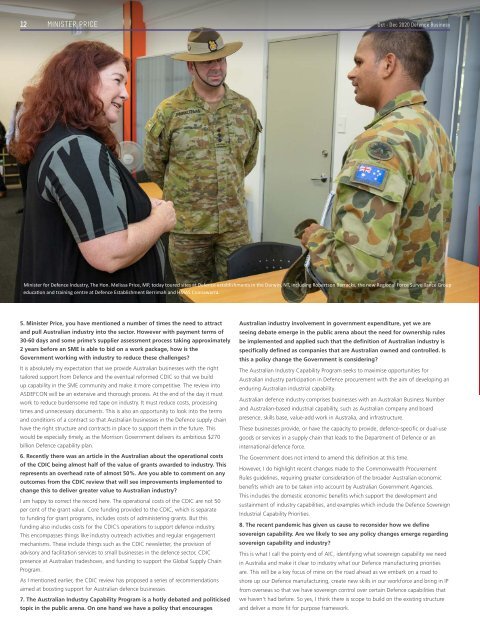Defence Business Issue 52 OCT-DEC 2020
Create successful ePaper yourself
Turn your PDF publications into a flip-book with our unique Google optimized e-Paper software.
MINISTER PRICE<br />
12 Oct - Dec <strong>2020</strong> <strong>Defence</strong> <strong>Business</strong><br />
Minister for <strong>Defence</strong> Industry, The Hon. Melissa Price, MP, today toured sites at <strong>Defence</strong> establishments in the Darwin, NT, including Robertson Barracks, the new Regional Force Surveillance Group<br />
education and training centre at <strong>Defence</strong> Establishment Berrimah and HMAS Coonawarra.<br />
5. Minister Price, you have mentioned a number of times the need to attract<br />
and pull Australian industry into the sector. However with payment terms of<br />
30-60 days and some prime’s supplier assessment process taking approximately<br />
2 years before an SME is able to bid on a work package, how is the<br />
Government working with industry to reduce these challenges?<br />
It is absolutely my expectation that we provide Australian businesses with the right<br />
tailored support from <strong>Defence</strong> and the eventual reformed CDIC so that we build<br />
up capability in the SME community and make it more competitive. The review into<br />
ASDEFCON will be an extensive and thorough process. At the end of the day it must<br />
work to reduce burdensome red tape on industry. It must reduce costs, processing<br />
times and unnecessary documents. This is also an opportunity to look into the terms<br />
and conditions of a contract so that Australian businesses in the <strong>Defence</strong> supply chain<br />
have the right structure and contracts in place to support them in the future. This<br />
would be especially timely, as the Morrison Government delivers its ambitious $270<br />
billion <strong>Defence</strong> capability plan.<br />
6. Recently there was an article in the Australian about the operational costs<br />
of the CDIC being almost half of the value of grants awarded to industry. This<br />
represents an overhead rate of almost 50%. Are you able to comment on any<br />
outcomes from the CDIC review that will see improvements implemented to<br />
change this to deliver greater value to Australian industry?<br />
I am happy to correct the record here. The operational costs of the CDIC are not 50<br />
per cent of the grant value. Core funding provided to the CDIC, which is separate<br />
to funding for grant programs, includes costs of administering grants. But this<br />
funding also includes costs for the CDIC’s operations to support defence industry.<br />
This encompasses things like industry outreach activities and regular engagement<br />
mechanisms. These include things such as the CDIC newsletter, the provision of<br />
advisory and facilitation services to small businesses in the defence sector, CDIC<br />
presence at Australian tradeshows, and funding to support the Global Supply Chain<br />
Program.<br />
As I mentioned earlier, the CDIC review has proposed a series of recommendations<br />
aimed at boosting support for Australian defence businesses.<br />
7. The Australian Industry Capability Program is a hotly debated and politicised<br />
topic in the public arena. On one hand we have a policy that encourages<br />
Australian industry involvement in government expenditure, yet we are<br />
seeing debate emerge in the public arena about the need for ownership rules<br />
be implemented and applied such that the definition of Australian industry is<br />
specifically defined as companies that are Australian owned and controlled. Is<br />
this a policy change the Government is considering?<br />
The Australian Industry Capability Program seeks to maximise opportunities for<br />
Australian industry participation in <strong>Defence</strong> procurement with the aim of developing an<br />
enduring Australian industrial capability.<br />
Australian defence industry comprises businesses with an Australian <strong>Business</strong> Number<br />
and Australian-based industrial capability, such as Australian company and board<br />
presence, skills base, value-add work in Australia, and infrastructure.<br />
These businesses provide, or have the capacity to provide, defence-specific or dual-use<br />
goods or services in a supply chain that leads to the Department of <strong>Defence</strong> or an<br />
international defence force.<br />
The Government does not intend to amend this definition at this time.<br />
However, I do highlight recent changes made to the Commonwealth Procurement<br />
Rules guidelines, requiring greater consideration of the broader Australian economic<br />
benefits which are to be taken into account by Australian Government Agencies.<br />
This includes the domestic economic benefits which support the development and<br />
sustainment of industry capabilities, and examples which include the <strong>Defence</strong> Sovereign<br />
Industrial Capability Priorities.<br />
8. The recent pandemic has given us cause to reconsider how we define<br />
sovereign capability. Are we likely to see any policy changes emerge regarding<br />
sovereign capability and industry?<br />
This is what I call the pointy end of AIC, identifying what sovereign capability we need<br />
in Australia and make it clear to industry what our <strong>Defence</strong> manufacturing priorities<br />
are. This will be a key focus of mine on the road ahead as we embark on a road to<br />
shore up our <strong>Defence</strong> manufacturing, create new skills in our workforce and bring in IP<br />
from overseas so that we have sovereign control over certain <strong>Defence</strong> capabilities that<br />
we haven't had before. So yes, I think there is scope to build on the existing structure<br />
and deliver a more fit for purpose framework.


















